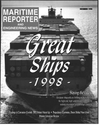
Page 36: of Maritime Reporter Magazine (December 1998)
Read this page in Pdf, Flash or Html5 edition of December 1998 Maritime Reporter Magazine
PICKUPCAT
TERMINALS AND TRANSPORTATION FOR LESS .
The cargo unit may serve as a floating storage facil- ity, independently of the propulsion unit which is free to operate elsewhere.
While at sea, the two units operate as one ship.
Munkedamsveien 59 B, 0270 OSLO, Norway.
Phone: ( + 47) 23 1 1 58 80
Fax: ( + 47) 23 1 1 58 99 e-mail: [email protected]
URL: http://www.pickupcat.com
The PICKUPCAT concept is based on dividing a vessel in two seperate parts: a self contained catamaran containing power, propulsion and steering functions and an interchangeable cargo carrying unit.
Hanjin Heavy
Industries Co. Ltd.
Vessel name Segero
Vessel type Cable layer
Owner/Operator Korea Submarine
Telecom Co. Ltd.
Segero was designed to carry out the laying, burying and repair of intercontinental submarine optical fiber, with particular reference to the severe weather conditions, in terms of wind and sea state, and extremely low temperatures, of the
North Pacific. The design follows the fully stern-working concept, which permits work to continue even in the worst weather condi- tions, and, by allowing a conven- tional bow-form to be adopted, pro- viding for a high cruising speed.
All important bridge equipment, crucial in the successful operation of these vessel types, includes a
Kongsberg Simrad integrated monitoring and control system (IMCS), which consists of dynamic positioning system, thruster con- trol system and vessel control sys- tem. The dynamic positioning sys- tem incorporates special sensors, functions and operational modes which are related to the cable lay- ing and trenching applications.
The thruster control system incor- porates lever control of each thruster, as well as an indepen- dent joystick system with common control of all selected thrusters.
The vessel control system incorpo- rates alarm monitoring and con- trol system, including power man- agement functions. The ship is also equipped with the STN Atlas total navigation system, including
Radar, doppler sonar, echo sounder as well as JRC GMDSS. To provide more comfortable working and liv- ing conditions for the ship's com- plement of 63, a longer rolling period has been achieved using sufficiently large and long bilge keels, the active anti-rolling tanks.
The diesel-electric power system is based on four ABB generators, two of 3,400 kVA, one of 2,300 kVA and one of 850 kVA, driven by
MAN 8L32/40 (4,800 ps), 6L32/40 (3,600 ps) and 6L23/30H (1,300 ps) engines, respectively. Electric power is distributed through two main switchboards, with four transformers, supplying two 2,700 kW ABB propulsion motors which drive two Kamewa Azimuth propulsion units. The propellers are fitted with steerable nozzles to help prevent cable fouling.
Additional maneuverability is pro- vided via a pair of Lips 1,200 kW tunnel thrusters and a 1,500 kW
White Gill vectoring unit operat- ing forward.
Most cable work is concentrated on the continuous, mainly closed, upper deck, using two 3.6-m diam- eter stern sheaves straddled by a 35-ton swl A-frame. This can work (Continued on page 53)
Maritime Reporter/Engineering News
Kongsberg Norcontrol AS, P.O.Box 1009, N-3194 Horten, Norway
Tel.: +47 33 03 20 00 Fax: +47 33 04 22 50 e-mail: automation @ norcontrol.com www.norcontrol.com
The assembled units retain the same strength and structural properties as that of a traditional hull construction. The time spent in port to engage/disengage the two seperate units takes less than 2 hours.
Take control today, - and find out more about what makes
Kongsberg Norcontrol leaders in ship automation.
KONGSBERG
NORCONTROL
Circle 250 on Reader Service Card
Circle 274 on Reader Service Card
Today's shipping is complicated and puts ever increasing demand on the people who run the business.
As world leaders in ship automation, with more than 30 years of experience in marine electronics, Kongsberg
Norcontrol knows that the operators' skills and experience combined with functional and reliable systems make the best applications.
Every ships crew and support team deserve properly designed propulsion control, navigation bridge, cargo handling, communication and alarm, monitoring and control systems.

 35
35

 37
37
